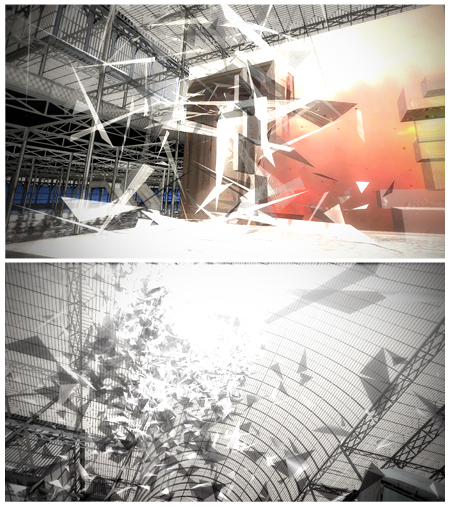The erudite artist on his installation which explores the simulated architecture of Crystal Palace, as part of group exhibition Re.presence
Shiva’s Dreaming: Crystal Palace (Trailer) from Lawrence Lek on Vimeo.
Coinciding with this year’s Clerkenwell Design Week, Sto Werkstatt have unveiled their latest exhibition, Re.presence: How To See Architecture, in which five artists and designers tackle the complexity of representing architecture in a range of mediums. Sculptor Lawrence Lek’s installation, ‘Shiva’s Dreaming’, considers the impact digital architecture can have, as players are invited to digitally roam around a simulated replica of Crystal Palace on 30 November 1936, the evening it burnt to the ground. We talk to Lek about his installation, and the frontiers his work seeks to push.
Betty Wood: What does the title ‘Shiva’s Dreaming’ mean?
Lawrence Lek: I’m interested in how the primal impulse to create and destroy shapes the world. In Hindu mythology, Shiva is the god of transformation, often shown as a dancer encircled by fire to symbolise the continuous cycle of creation and destruction. Although the religious symbols rituals of mythology have given way to entertainment and technology, the spirit of Shiva is timeless.
‘God Mode’ is a term used in computer games when the player gains special powers like invincibility, unlimited weaponry or the ability to fly or walk through walls. These worlds are different to reality: they are a place to act out the desire to explore, to create, and to destroy. I wanted to create a work that took any reference to a goal out of ‘Shiva’s Dreaming’, in order to expose these fundamental relationships and to bring out the dreamlike qualities of the game.
BW: Where did the idea of simulating the 1936 fire at Crystal Palace come from?
LL: The Crystal Palace was built in 1851 for the Great Exhibition in Hyde Park, and was afterwards transferred to Sydenham before it burnt down in 1936. Although it was such a landmark – a 600 metre long glasshouse for exhibiting machines and objects from around the world – it quickly became obsolete, a part of the Victorian landscape of London.
“The industrial revolution of the 19th century has many parallels with our current fascination with digitally-driven progress”

The Crystal Palace’s history of erasure – built, moved, and burnt – makes it the ideal site for the themes of ‘Shiva’s Dreaming.’ The industrial revolution of the 19th century has many parallels with our current fascination with digitally-driven progress, and the Crystal Palace demonstrates how transient the life of technological monuments can be.
BW: Are you exploring ‘digital danger’ in Shiva’s Dreaming?
LL: I’m not exploring danger – this is much better served by horror or thriller movies, works that unfold in an exact predetermined sequence, using cinematography and editing to create the feeling of danger in the viewer. I want to do the opposite: to eliminate the sense of danger, in order to free the player’s will to explore.
In the game, the virtual Crystal Palace is filled with glass objects continuously raining down on the player and fires burning with artificial intensity. Of course, the viewer understands that neither of these pose a physical danger, which allows them to get closer to the audio-visual presence of these phenomena. In the game, the glass shards explode into glittering fragments that dance to their own visual logic, and acoustics are heightened – sounds are louder, denser, closer. The simulation is not real, but the experience is.
BW: Building on this sense of ‘experience’, what are some of the other advantages of digital architecture?
LL: Virtual worlds have the advantage of combining the last century of developments in cinematic techniques, sound engineering, visual arts, computing technology, and industrial design. You have a nearly infinite range of cameras, microphones, colours, processes, interfaces, and samples – all of which help you create the illusion of a self-contained universe. However, the viewer is disembodied: they are not ‘there’. That is the limitation: it’s a problem of presence.

BW: How do architecture practices utilise technologies such as this in their work?
LL: The construction industry, of which architecture practices are a part, use visualisation to sell. It’s usually static digital renderings of the new design, or maybe a fly-through style animation if it’s really important. Designs change so rapidly that it doesn’t make commercial sense to invest in visualisation technologies. Also, it’s unlikely that the decision makers who commission buildings grew up playing first-person shooter games. Maybe in 20 years everybody will be in meetings with amazing interactive worlds to fly through.
BW: On a philosophical note, do you think utopia is only achievable digitally?
LL: I don’t think utopia is a place, but a practice. It is the attempt to construct an ideal world whose forms, laws, rituals, and disorders have space to exist freely. It is not achievable on a global scale simply because the present moment is largely driven by economic sustenance and therefore evolves at a faster rate than the development of ethical philosophies and political practices, which require periods of retreat and reflection. So I would say that utopia is achievable not as a totality, but as a fragment. Literature is the traditional realm of utopia – especially in the economic philosophy and science fiction sections – but today virtual worlds can provide an alternative site.
Read more about Lawrence’s work on his homepage. To read more about the exhibition, click here. ‘Re.presence’ runs from today until 21st July at Sto Werkstatt, 7-9 Woodbridge Street, Clerkenwell EC1R 0LL




